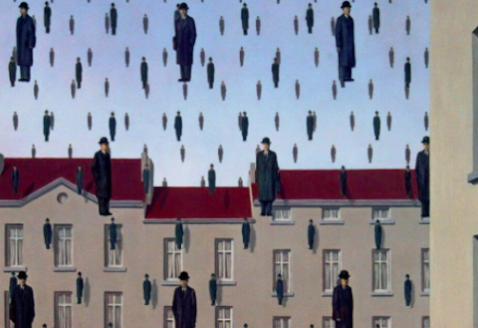Elements of René Magritte's Golconda
Golconda, 1953, Oil on Canvass
20th century surrealist René Magritte's Golconda illustrates near-identical men in the fore, mid and background all of whom wear similar pieces of clothing. Some of these articles are chatacteristic of Magritte, born at the turn of the century and a recognizable figure in during the Surrealism period. Surrealists such as Magritte take the ordinary and make something unconventional and rather bizarre. Doves depicted across hidden faces, or faces clothed and kissing, these personal touches of the artist are complemented with his sharp vivid lines and deep black colors found in long coats and curved bowler caps. His work often utilizes tone to portray depth in images, but more strong does it create dramatic spatial relationships between objects, and feelings of uneasiness.
The common use of blacks opposed to lighter colors emphasizes the discomforting nature of his subjects, albeit the lighter colors often come with everyday items such as birds, or clouds. In this way color is less symbolic, and more of a mode to force ones focus on the dramatic.
Lastly, with textured clouds, clothes and objects do the works of Magritte truly come to life in the slight faces depicted in portrait paintings, or in the long fellows' coats seen floating above the streets of Golconda.
I was taken to this particular artists' work because of a children's book I've been reading to my baby nephew, Tuesday by David Weisner. Written in 1991 and equally humorous for its unreal realism, it's wordless and demands the reader to think of and feel what he/she is looking at, and I appreciated that greatly. Easily, if I had to choose reading Tuesday or The Little Engine That Could, (one of his favorites), I vote for the unfamiliar and visually engaging.
Works Cited
Golconda, 1953 by Rene Magritte, www.renemagritte.org/golconda.jsp.




Hi Addison, what an enlightening analysis! The way color contrast is used is so intuitive but I don't think I would have consciously noticed it if you hadn't pointed it out. The blacks against a serene background, coupled with the clone-like repetition of the subjects is unsettling and meaningful. I think Magritte was clearly expressing something about the mechanical rigidity of modern life (in the 50's.) The people are like a colony of ants amongst a city with just as much regularity At first glance I wasn't impressed with this painting but your analysis helped me find so much to appreciate and ponder in it.
ReplyDeleteHi Addison, I really like this piece of art and it is great that you chose that one. I will also look into those children books and the author, because I find this very interesting and need to check it out. Thank you for adding the link and you brought the analysis to the point.
ReplyDelete